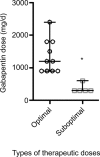Identification, prevalence, and treatment of painful diabetic neuropathy in patients from a rural area in South Carolina
- PMID: 28435320
- PMCID: PMC5391160
- DOI: 10.2147/JPR.S129139
Identification, prevalence, and treatment of painful diabetic neuropathy in patients from a rural area in South Carolina
Abstract
Diabetic peripheral neuropathy (DPN) represents significant burdens to many patients and the public health-care system. Patients with diabetes in rural areas have higher risk of developing complications and having less access to proper treatment. We studied a rural population of patients with diabetes who attended a pharmacist-led free clinic for a diabetic education program. Our objectives were to 1) determine the prevalence of DPN and painful diabetic neuropathy (p-DN) in patients with type 2 diabetes; 2) assess the proportion of patients with DPN and p-DN left undocumented upon physician referral to a pharmacist-led free clinic; and 3) determine the appropriateness of pain medication regimen. We performed a retrospective analysis of clinical records of patients from the Presbyterian College School of Pharmacy (PCSP) Wellness Center located in Clinton, SC. Diagnoses of DPN and/or p-DN were obtained from referral notes in the clinical records and compared with results from foot examinations performed in the free clinic and clinical features. Medication regimens were also obtained and compared using American Academy of Neurology (AAN) treatment guidelines. Within our study population (n=111), the prevalence of DPN was 62.2% (national average of 28%-45%) and that of p-DN was 23.4% (national average of 11%-24%). In p-DN patients (n=26), 53.8% (n=14) had a documented diagnosis of p-DN by the referring physician, and 46.2% (n=12) were identified by the pharmacists. A total of 95% (19 of 20) of the patients treated for p-DN received adequate pharmacological agents, though suboptimal as per clinical guidelines. More than 50% of the patients used subtherapeutic doses of their medications. Gabapentin was the most frequently used medication in our population (65.4%). Patients in rural South Carolina had a higher prevalence of DPN and p-DN with >60% undocumented cases of p-DN. More than 95% of treated patients did not receive optimum therapy according to AAN guidelines.
Keywords: chronic pain free clinic; diabetes educator; gabapentin; pain; pharmacist-led diabetes clinic; polysensory neuropathy.
Conflict of interest statement
Disclosure The authors report no conflicts of interest in this work.
Figures




References
-
- Prevention CfDCa . National Diabetes Statistics Report: Estimates of Diabetes and Its Burden in the United States. Atlanta, GA: U.S. Department of Health and Human Services; 2014.
-
- Massey CN, Appel SJ, Buchanan KL, Cherrington AL. Improving diabetes care in rural communities: an overview of current initiatives and a call for renewed efforts. Clin Diab. 2010;28(1):20–27.
-
- Brown-Guion SY, Youngerman SM, Hernandez-Tejada MA, Dismuke CE, Egede LE. Racial/ethnic, regional, and rural/urban differences in receipt of diabetes education. Diabetes Educ. 2013;39(3):327–334. - PubMed
LinkOut - more resources
Full Text Sources
Other Literature Sources

